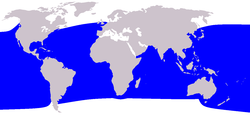Pygmy Sperm Whale
|
|
| Pygmy Sperm Whale Conservation status: Lower risk | ||||||||||||||||||
|---|---|---|---|---|---|---|---|---|---|---|---|---|---|---|---|---|---|---|
| Scientific classification | ||||||||||||||||||
| ||||||||||||||||||
| Binomial name | ||||||||||||||||||
| Kogia breviceps Blainville, 1838 | ||||||||||||||||||
 Pymgy Sperm Whale range |
The Pygmy Sperm Whale (Kogia breviceps) is one of three species of whale in the sperm whale family. They are not often sighted at sea and most of our understanding of the creatures comes from the study of washed-up specimens
| Contents |
Taxonomy
There has been debate and differing opinion as to the correct classification of the Pygmy and Dwarf Sperm Whales (see sperm whale family for details). Until 1966, the two species were widely considered to actually be the same species. That year a scientist at the Smithsonian Institute definitively diagnosed them as separate species. The Pygmy Sperm Whale was first named by Blainville in 1838.
Physical description
Like its giant cousin, the Sperm Whale, the Pygmy Sperm Whale has a spermaceti organ in its forehead (see Sperm Whale for a discussion of its purpose). It also has a sac in its intestines that contains a dark red fluid. The whale will expel this fluid when frightened. Its purpose is believed to be to confuse and disorientate predators.
The Pygmy Sperm is amongst the smallest of all whales and is not much larger than many dolphins. They are about 1.2m at birth, growing to about 3.5m at maturity. Adults weigh about 400kg. Roughly speaking the underside is a creamy, occasionally pinkish, colour and the back and sides are a bluish grey. However there is considerable intermixing between the two colours. The head is large in comparison to body size, given an almost swollen appearance when viewed from the side. The lower jaw is very small and slung low. The blowhole is displaced slightly to the left when viewed from above facing forward. The dorsal fin is very small indeed and hooked. Its size is considerablely smaller than the Dwarf Sperm Whale and may this may be used for diagnostic purposes. The Pygmy Sperm has between 20 and 32 teeth all of which are set into the lower jaw only. There is a false gill behind each eye.
This whale makes very inconspicious movements. It rises to the surface slowly, with little splash or blow, and will remain there motionless for some time. In Japan the whale was historically known as the "floating whale" because of this. Its dive is equally lacking in grand flourish - it simply drops out of view. The species has a tendency to back away from rather than approach boats. Breaching has been observed, but is not common.
Pygmy Sperms are usually solitary creatures but have been seen in groups of up to six. Primary food sources are squid and crabs.
Population and distribution
Pymgy Sperm Whales are found in the temperature waters of the Atlantic, Pacific and Indian Oceans. However they are rarely sighted at sea so most data comes from stranded animals - making a precise range and migration map difficult. They are believed to prefer off-shore waters. Their status is usually described as rare but occasional patches of higher density of strandings suggest it may be more common rather previously supposed. The total population is unknown.
Human interaction
Pymgy Sperm Whales have never been hunted on a wide scale. Land-based whales have hunted them from Indonesia, Japan and the Lesser Antilles. Individuals have also been recorded killed in drift nets. Some stranded animals have been found with plastic bags in their stomachs - which may be a cause for concern. It is not known whether these activities are causing long-term damage to the survival of the species.
References
- Pygmy and Dwarf Sperm Whales by Donald F. McAlpine in Encyclopedia of Marine Mammals pp. 1007-1009 ISBN 01255513402
- Whales Dolphins and Porpoises, Mark Carwardine, Dorling Kindersley Handbooks, ISBN 0751327816
- National Audubon Society Guide to Marine Mammals of the World, Reeves, Stewart, Clapham and Powell, ISBN 0375411410de:Zwergpottwal
